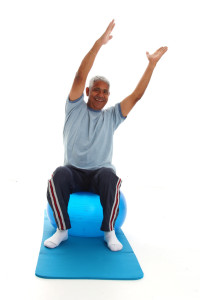Houston Winters Great for Exercise

It’s a new year and time for a new routine! During the holidays we probably let our senior exercise routine lapse. No, wrapping presents and repeatedly checking the temperature of the turkey doesn’t count!
So for many of us, exercise showed up on our list of New Year’s resolutions—just at the point when the weather and short days can make it more of a challenge to get a good workout!
Our need for exercise doesn’t take a winter break. For people of every age, and especially for older adults, physical activity is a vital part of good physical, emotional and mental health. A sedentary lifestyle leads to unhealthy weight gain, depression, sleep problems and a host of other health problems. And if we completely slack during the winter, we’re at higher risk of injury when we resume exercise in the spring.
But the good news is that people of every age can still remain fit by changing our routine for the season, and by taking a few simple health and safety precautions. Here are some options for making it happen.
Continuing Your Outdoor Routine
Sometimes the temperatures are too cold to make outdoor exercise safe, especially for seniors who are unable to move at a brisk pace. But if walking, cycling or other outdoor activities are part of your or your love one’s fitness routine, you don’t necessarily have to take a break during the colder months. To safely continue your outdoor regimen for winter, remember:
For comfort and to avoid hypothermia (a dangerous drop in body temperature), dress right for cold temperatures and wind. Wearing several layers of water- and wind-resistant clothing is the best way to hold in body heat, and you can shed or add layers as you warm up and cool down. Don’t forget a hat or hood, gloves and scarf.
If you wear rain gear, choose a fabric that “breathes.” Sporting goods and outdoor wear stores feature a variety of high-tech materials that repel water and block the wind, but allow perspiration to evaporate.
Your shoes should be waterproof, well-fitted, with good traction and ankle support. Keep feet dry and warm with the right socks.
- Pay attention to the weather, and be aware of the wind chill factor. On windy days, your body temperature can lower much faster. Be aware of the symptoms of hypothermia and frostbite. If you walk at dusk or after dark, make yourself more visible by wearing reflective clothing. Carry a flashlight. Be extra cautious when crossing streets. Remember, it is harder for drivers to see you than it is for you to see them!
- Don’t neglect your warm-up. A longer stretching phase and slower movements at the beginning of your workout help prevent muscle or tendon injury.
- Use caution and good sense to avoid any situation or condition that might trip you up, such as ice, slippery leaves and poorly lit walkways.
- Dry, cold winter air can lead to dehydration, so drink plenty of water.
Give Winter Sports a Try
If your area gets snow in the winter and if your healthcare provider gives you the thumbs up, try snowshoeing or cross-country skiing. Keep in mind the precautions above, and in addition:
- If you’re a first-timer or inexperienced, be sure to get professional training first.
- Know the weather conditions before you head out in the snow, and keep wind chill in mind
- Don’t go out alone, and bring your phone.
- Bring snacks and water.
- Use appropriate gear, in good condition.
- Remember to dress warmly in layers to avoid the danger of hypothermia, frostbite and other cold injuries.
- Sunblock and sunglasses are as important during snow sports as in the summer.
Check Out Indoor Exercise Opportunities
When the weather is just too miserable or it’s too dark, alternate with indoor fitness activities. This might be the year to:
- Join a gym.
- Check out local senior fitness classes.
- Take up mall walking, or go to an indoor track.
- Take a swimming or water aerobics class at an indoor pool.
- Go bowling or dancing with friends.
- Invest in a treadmill or other home exercise equipment.
- Work out at home with an exercise or tai chi video; keep a set of weights near the TV even if you’re just watching a movie.
- Remember, before starting any new or expanded exercise program, talk to your healthcare provider, especially if you’re beginning new activities.
Winter doesn’t mean hibernation. You still should get 30 minutes or more of physical exercise most days of the week. But with a little planning and preparation, you can continue to be active even in the winter months.
Source: IlluminAge AgeWise

